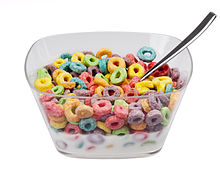
Back অতি-প্রক্রিয়াজাত খাদ্য Bengali/Bangla Aliments ultraprocessats Catalan Průmyslově zpracované potraviny Czech Ultraforarbejdede fødevarer Danish Hochverarbeitete Lebensmittel German Alimento ultraprocesado Spanish خوراک فوق فرآوری Persian Ultraprosessoitu ruoka Finnish Aliment ultratransformé French Makanan ultra proses ID
It has been suggested that Health effects of ultra-processed foods be merged into this article. (Discuss) Proposed since January 2025. |


An ultra-processed food (UPF) is a grouping of processed food characterized by relatively involved methods of production. There is no single definition of UPF, but they are generally understood to be an industrial creation derived from natural food or synthesized from other organic compounds.[1][2] The resulting products are designed to be highly profitable, convenient, and hyperpalatable, often through food additives such as preservatives, colourings, and flavourings.[3] UPFs have often undergone processes such as moulding/extruding, hydrogenation, or frying.[4]
Ultra-processed foods first became ubiquitous in the 1980s,[5] though the term "ultra-processed food" gained prominence from a 2009 paper by Brazilian researchers as part of the Nova classification system.[6] In the Nova system, UPFs include most bread and other massed-produced baked goods, frozen pizza, instant noodles, flavored yogurt, fruit and milk drinks, diet products, baby food, and most of what is considered junk food.[7][8] The Nova definition considers ingredients, processing, and how products are marketed;[9] nutritional content is not evaluated.[10] As of 2024, research into the effects of UPFs is rapidly evolving.[11][4]
Since the 1990s, UPF sales have consistently increased or remained high in most countries. While national data is limited, as of 2023, the United States and the United Kingdom lead the consumption rankings, with 58% and 57% of daily calories, respectively. Consumption varies widely across countries, ranging from 25% to 35%. Chile, France, Mexico, and Spain fall within this range, while Colombia, Italy, and Taiwan have consumption levels of 20% or less.[4]
Epidemiological data suggest that consumption of ultra-processed foods is associated with non-communicable diseases and obesity.[12] A 2024 meta-analysis published in The BMJ identified 32 studies that associated UPF with negative health outcomes, though it also noted a possible heterogeneity among sub-groups of UPF. The specific mechanism of the effects was not clear.[11]
Some authors have criticised the concept of "ultra-processed foods" as poorly defined, and the Nova classification system as too focused on the type rather than the amount of food consumed.[13] Other authors, mostly in the field of nutrition, have been critical of the lack of attributed mechanisms for the health effects, focusing on how the current research evidence does not provide specific explanations for how ultra-processed food affects body systems.[14]
- ^ Monteiro C (2010). "The big issue is ultra-processing". World Nutrition. 1 (6): 237–269. ISSN 2041-9775.
- ^ Monteiro C (2011). "The big issue is ultra-processing. Why bread, hot dogs – and margarine – are ultra-processed". World Nutrition. 2 (10): 534–549. ISSN 2041-9775.
- ^ Monteiro CA, Cannon G, Levy RB, Moubarac JC, Louzada ML, Rauber F, et al. (April 2019). "Ultra-processed foods: what they are and how to identify them". Public Health Nutrition. 22 (5): 936–941. doi:10.1017/S1368980018003762. PMC 10260459. PMID 30744710.
- ^ a b c Touvier M, da Costa Louzada ML, Mozaffarian D, Baker P, Juul F, Srour B (October 2023). "Ultra-processed foods and cardiometabolic health: public health policies to reduce consumption cannot wait". BMJ. 383: e075294. doi:10.1136/bmj-2023-075294. PMC 10561017. PMID 37813465.
- ^ Fardet A (2018). "Characterization of the Degree of Food Processing in Relation With Its Health Potential and Effects". Advances in Food and Nutrition Research. Vol. 85. Elsevier. pp. 79–129. doi:10.1016/bs.afnr.2018.02.002. ISBN 978-0-12-815089-4. PMID 29860978.
- ^ Cite error: The named reference
Monteiro2010was invoked but never defined (see the help page). - ^ Cite error: The named reference
Gibney2019was invoked but never defined (see the help page). - ^ Dixon R (Sep 6, 2023). "Ultra-processed foods: the 19 things everyone needs to know". The Guardian. Retrieved Sep 24, 2024.
- ^ Cite error: The named reference
Monteiro2009was invoked but never defined (see the help page). - ^ Cite error: The named reference
:1was invoked but never defined (see the help page). - ^ a b Lane MM, Gamage E, Du S, Ashtree DN, McGuinness AJ, Gauci S, et al. (February 2024). "Ultra-processed food exposure and adverse health outcomes: umbrella review of epidemiological meta-analyses". BMJ. 384: e077310. doi:10.1136/bmj-2023-077310. PMC 10899807. PMID 38418082.
- ^ Pagliai G, Dinu M, Madarena MP, Bonaccio M, Iacoviello L, Sofi F (February 2021). "Consumption of ultra-processed foods and health status: a systematic review and meta-analysis". The British Journal of Nutrition. 125 (3): 308–318. doi:10.1017/S0007114520002688. PMC 7844609. PMID 32792031.
- ^ Visioli F, Marangoni F, Fogliano V, Del Rio D, Martinez JA, Kuhnle G, et al. (December 2023). "The ultra-processed foods hypothesis: a product processed well beyond the basic ingredients in the package". Nutrition Research Reviews. 36 (2): 340–350. doi:10.1017/S0954422422000117. hdl:11577/3451280. PMID 35730561.
- ^ Valicente VM, Peng CH, Pacheco KN, Lin L, Kielb EI, Dawoodani E, et al. (July 2023). "Ultraprocessed Foods and Obesity Risk: A Critical Review of Reported Mechanisms". Advances in Nutrition. 14 (4): 718–738. doi:10.1016/j.advnut.2023.04.006. PMC 10334162. PMID 37080461.